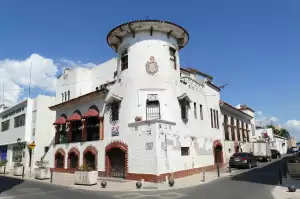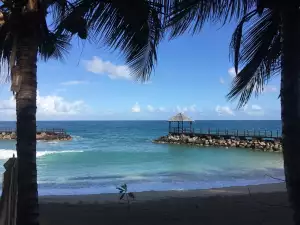Dominican Republic: Caribbean Rhythms Meet Colonial Charm

- Explore Santo Domingo
- Relax on Punta Cana beaches
- Adventure in Samana Peninsula
- Explore Nature's Wonders
- Experience Local Charm
- Create Lasting Memories
- Hike to Pico Duarte
- Discover Colonial Zone history
- Experience vibrant Dominican culture
- Taste delicious Dominican cuisine
- Enjoy Merengue and Bachata music
- Visit ancient Taino sites
- Witness baseball's Dominican passion
Explore Santo Domingo
Santo Domingo, the capital of the Dominican Republic, pulsates with a vibrant energy that blends old-world charm with modern Latin flair. Founded in 1496, it stands as the oldest European city in the Americas, boasting a UNESCO World Heritage-listed Colonial Zone. Wander through cobblestone streets lined with colorful Spanish colonial architecture, grand plazas, and historic churches. Visit the First Cathedral of the Americas, a magnificent Gothic structure dating back to the 16th century.
Explore the Alcázar de Colón, once the palace of Diego Columbus, son of Christopher Columbus, and now a museum showcasing colonial artifacts. Immerse yourself in the city's rich history at the Museo de las Casas Reales, which chronicles the Spanish colonial era. For a taste of local life, stroll through the Mercado Modelo, a bustling market brimming with Dominican crafts, souvenirs, and vibrant artwork.
Indulge in the city's culinary scene, savoring traditional Dominican dishes like La Bandera (stewed meat, rice, and beans) or fresh seafood with a Caribbean twist. As the sun sets, experience the city's vibrant nightlife, from lively bars and clubs to traditional merengue and bachata dance halls. Santo Domingo offers a captivating journey through time and culture, leaving a lasting impression on every visitor.
Relax on Punta Cana beaches
The Dominican Republic, a country located on the island of Hispaniola in the Greater Antilles archipelago of the Caribbean region, boasts some of the most stunning beaches in the world. And when it comes to beach destinations in the Dominican Republic, Punta Cana reigns supreme. With its powdery white sand, crystal-clear turquoise waters, and swaying palm trees, Punta Cana is a tropical paradise that offers the ultimate beach getaway.
Whether you're seeking relaxation, adventure, or a mix of both, Punta Cana's beaches have something for everyone. Spend your days lounging on the soft sand, soaking up the warm Caribbean sun, and taking refreshing dips in the ocean. For the more active, a wide range of water sports is available, including swimming, snorkeling, diving, windsurfing, and sailing. Explore the vibrant coral reefs teeming with marine life, or embark on a thrilling fishing expedition.
As the sun begins to set, witness the sky explode in a kaleidoscope of colors as you stroll along the shore. The beaches of Punta Cana offer a front-row seat to some of the most magical sunsets you'll ever witness. With its idyllic setting, endless activities, and vibrant culture, Punta Cana is a dream destination for beach lovers and sun-seekers alike.
Adventure in Samana Peninsula
Escape the ordinary on the Samaná Peninsula, a hidden gem on the Dominican Republic's northeastern coast. Unlike the bustling resorts of Punta Cana, Samaná offers lush rainforests, secluded beaches, and charming fishing villages.
Explore Nature's Wonders
Hike through Los Haitises National Park, a breathtaking landscape of mangrove forests, limestone cliffs, and caves adorned with ancient Taino pictographs. Birdwatchers will delight in spotting numerous species, including the Hispaniolan parrot and the magnificent frigatebird.
From January to March, embark on an unforgettable whale-watching excursion. Witness the awe-inspiring spectacle of thousands of humpback whales migrating to the warm waters off Samaná's coast to mate and calve.
No trip is complete without a visit to El Limón Waterfall. Nestled within the rainforest, this 50-meter cascade is accessible by foot or horseback. Take a refreshing dip in the cool, clear waters of the natural pool at its base.
Experience Local Charm
Visit the charming fishing village of Las Galeras, where you can savor fresh seafood at a beachfront restaurant or relax on the pristine sands of Playa Rincón, often hailed as one of the world's most beautiful beaches.
Create Lasting Memories
Samaná offers a unique blend of adventure, nature, and culture. Whether you seek thrills, tranquility, or a glimpse into the Dominican Republic's rich heritage, the Samaná Peninsula will captivate your senses and leave you with lasting memories.
Hike to Pico Duarte
Pico Duarte stands tall as the highest peak in the Caribbean, reaching an impressive elevation of 3,087 meters (10,128 feet) above sea level. Located in the heart of the Dominican Republic, this majestic mountain beckons adventurers and nature enthusiasts alike to conquer its challenging yet rewarding trails.
The hike to Pico Duarte is not for the faint of heart. It's a strenuous trek that typically takes two to three days to complete, depending on the chosen route and fitness level. The two most popular starting points for the adventure are Jarabacoa and San José de las Matas, both situated in the Cordillera Central mountain range.
Along the way, hikers are treated to breathtaking views of lush valleys, pristine rivers, and dense pine forests. The landscape changes dramatically with every step, showcasing the incredible biodiversity of the Dominican Republic. As you ascend higher, the air becomes cooler and thinner, adding an extra layer of challenge to the journey.
Camping is the only option for spending the night on the mountain, and there are designated campsites along the trails. The clear night skies offer unparalleled stargazing opportunities, far from the city lights. Reaching the summit of Pico Duarte is a truly exhilarating experience. Atop the peak, a bronze bust of Juan Pablo Duarte, one of the Dominican Republic's founding fathers, stands proudly. From this vantage point, hikers are rewarded with panoramic views that extend as far as the eye can see.
The best time to embark on this unforgettable adventure is during the dry season, which runs from December to April. During this time, the trails are in optimal condition, and the weather is generally pleasant. However, it's essential to be prepared for sudden changes in weather conditions, as mountain environments can be unpredictable.
Discover Colonial Zone history
Step into a time capsule and journey back to the heart of the New World. Founded in 1498, the Colonial Zone of Santo Domingo in the Dominican Republic is far more than just cobblestone streets and charming architecture. It's the first permanent European settlement in the Americas and a UNESCO World Heritage site. As you stroll through the vibrant streets, you'll encounter architectural wonders like the Catedral Primada de América, the oldest cathedral in the Americas, its imposing Gothic facade whispering tales of centuries past.
Pause at the Alcázar de Colón, once the palace of Diego Columbus, son of Christopher, and imagine the echoes of history within its coral stone walls. Every corner you turn reveals another treasure. The Museo de las Casas Reales, housed in a former Spanish colonial palace, offers a glimpse into the Dominican Republic's rich past. Explore the Fortaleza Ozama, the oldest military structure of its kind in the Americas, and let your imagination soar as you picture the arrival of Spanish galleons laden with treasures.
But the Colonial Zone is more than just a collection of historical buildings. It's a living, breathing neighborhood where the past seamlessly blends with the present. Enjoy a cup of Dominican coffee at a sidewalk café, listen to the rhythms of merengue and bachata spilling from local bars, and browse the vibrant shops offering handcrafted souvenirs. As you soak in the unique atmosphere, you'll understand why the Colonial Zone is considered the cradle of European civilization in the New World.
Experience vibrant Dominican culture
The Dominican Republic isn't just a place of stunning beaches and luxurious resorts, it's a country pulsating with a vibrant culture waiting to be explored. Immerse yourself in the captivating rhythms of Merengue and Bachata, the country's iconic music genres. Feel the energy as locals and visitors alike move their hips to these infectious beats. No trip is complete without experiencing the electrifying atmosphere of a Dominican fiesta. These lively celebrations are an explosion of music, dance, and delicious food, offering a glimpse into the heart and soul of the Dominican people.
Delve deeper into the country's history by exploring the Zona Colonial in Santo Domingo, a UNESCO World Heritage site. Wander through cobblestone streets lined with colonial-era architecture, visit the First Cathedral of the Americas, and imagine life in the New World's first European settlement. Beyond the cities, discover the warmth and hospitality of the Dominican people. Engage in conversations, sample local delicacies like La Bandera (the national dish), and learn about the country's rich traditions passed down through generations. Whether you're seeking vibrant nightlife, historical exploration, or simply a taste of authentic Caribbean culture, the Dominican Republic offers an unforgettable experience that will stay with you long after you've left its sunny shores.
Taste delicious Dominican cuisine
The Dominican Republic, a country located on the island of Hispaniola in the Greater Antilles archipelago of the Caribbean region, is a melting pot of cultures. This rich blend is reflected in its cuisine, a delightful fusion of Spanish, African, and indigenous Taíno influences.
Dominican food is known for its bold flavors, hearty portions, and use of fresh, local ingredients. One of the most iconic dishes is La Bandera, meaning "The Flag." This staple meal consists of white rice, stewed beans (habichuelas guisadas), and meat, usually chicken or beef. Another must-try is Sancocho, a hearty stew made with a variety of meats, root vegetables, and plantains. For a taste of the sea, try Pescado con Coco, fish cooked in coconut milk, or Camarones al Ajillo, shrimp sautéed in garlic sauce.
No Dominican meal is complete without trying Mangu, a traditional breakfast dish made with mashed plantains, often served with fried cheese, salami, or eggs. For a sweet treat, indulge in Habichuelas con Dulce, a creamy dessert soup made with beans, milk, sugar, and spices. And of course, no trip to the Dominican Republic is complete without sipping on a refreshing Presidente beer or a glass of Mamajuana, a local rum-based drink infused with herbs and spices.
Enjoy Merengue and Bachata music
The Dominican Republic pulsates with the rhythms of merengue and bachata, two genres deeply woven into the fabric of the nation's identity. Merengue, with its infectious energy and lively accordion melodies, is impossible to resist. Born in the Dominican countryside, it evolved over time, incorporating influences from European and African traditions. Today, it's the soundtrack of celebrations, festivals, and everyday life. Bachata, on the other hand, tugs at the heartstrings. This romantic genre, characterized by its soulful vocals and melancholic guitar riffs, originated in the Dominican Republic's rural communities. It speaks of love, heartbreak, and longing, resonating deeply with Dominicans and captivating audiences worldwide. No trip to the Dominican Republic is complete without experiencing the magic of merengue and bachata. Whether you're swaying to the music at a lively fiesta or listening to a heartfelt bachata ballad in a cozy bar, these genres offer a powerful connection to the soul of the Dominican people.
| Feature | Dominican Republic | Haiti |
|---|---|---|
| Official Language | Spanish | French, Haitian Creole |
| Land Area | 48,671 sq km | 27,750 sq km |
| Currency | Dominican Peso (DOP) | Gourde (HTG) |
Visit ancient Taino sites
The Dominican Republic, sharing the island of Hispaniola with Haiti, boasts a rich tapestry of indigenous history. Before the arrival of Christopher Columbus in 1492, the island thrived under the Taíno people. Today, remnants of their fascinating culture can be explored at various archaeological sites.
The Cueva de las Maravillas, or Cave of Wonders, located near La Romana, unveils a breathtaking display of Taíno pictographs. These ancient drawings offer a glimpse into their spiritual beliefs and daily lives. Another significant site is the Museo Arqueológico Regional Altos de Chavón, situated in a recreated 16th-century Mediterranean village. This museum houses an impressive collection of Taíno artifacts, including pottery, tools, and ceremonial objects, providing valuable insights into their craftsmanship and social structure.
For a more immersive experience, venture to the Parque Nacional Los Haitises. This national park, with its lush mangroves, secluded beaches, and limestone caves, was a sacred place for the Taíno. Explore the caves adorned with their petroglyphs, offering a profound connection to their spiritual practices and understanding of the natural world. Visiting these sites allows you to step back in time and appreciate the legacy of the Taíno, the original inhabitants of this beautiful Caribbean land.
Witness baseball's Dominican passion
The Dominican Republic shares the island of Hispaniola with Haiti. The country is known for its stunning beaches, lush rainforests, and vibrant culture. But there's one passion that unites Dominicans like no other: baseball. Baseball is more than just a game in the Dominican Republic. It's a way of life. From the young boys playing stickball in the streets to the cheering crowds at Estadio Quisqueya Juan Marichal in Santo Domingo, baseball is deeply ingrained in the country's identity.
The Dominican Republic has a long and storied baseball history. The country has produced some of the greatest players to ever grace the diamond, including Pedro Martinez, Juan Marichal, and David Ortiz. The love for the game is evident in the countless baseball academies scattered across the country. These academies provide young Dominican players with the opportunity to hone their skills and pursue their dreams of playing in the Major Leagues.
The passion for baseball in the Dominican Republic is infectious. When you're at a game, you can feel the energy and excitement in the air. The crowds are loud and passionate, and the players leave everything on the field. If you're a baseball fan, a trip to the Dominican Republic is a must. It's an opportunity to experience the game in its purest form and to witness the passion that makes it so special.
Published: 19. 07. 2024
Category: Destinations



